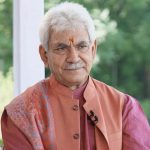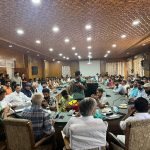Dr.SAJAD AHMAD MIR
Education System of Denmark
With a staggering 99% literacy rate, Denmark is unquestionably a top contender for the world’s best educational system. In Denmark, formal assessments and class rankings are not used in the classroom; instead, students work in groups and are trained to question the status quo. The students address teachers by their first names. Problem-solving skills are prioritised over memorization.
Education system in Denmark is divided into 3 stages:
- Folkeskole (grades 0-9, ages 6-16).
- Upper Secondary School (ages 16-19).
- Tertiary Education (college or university).
In Denmark, all levels of education, from elementary to higher education, are free. Also, the government of the nation has made sure that education is required for pupils up to the age of 16, which is one of the distinctive aspects used in the other education systems in the world. It is one of the best places to study abroad and draws a large number of international students from all over the world who have aspirations to complete their higher education at the renowned Danish universities that offer top-notch instruction and widely respected and acknowledged degrees. The top universities in Denmark are University of Copenhagen, Aarhus University, Technical University of Denmark (DTU), and Aalborg University.
Education System of Finland
Finland has also been internationally lauded for formulating the best education system in the world because the country has meticulously designed an educational apparatus that is at par with other countries across the globe. Finnish schools provide individual support to students who need it, which helps to ensure that every student has the opportunity to succeed. In addition, Finnish schools use innovative teaching methods that promote critical thinking, creativity, and a love for learning. These factors, combined with the highly trained and respected teachers in the system, have led to Finland being recognized as having one of the best education systems in the world.
Finland spends less on education than its neighbours Norway and Sweden, as well as nations like South Korea, Brazil, and Colombia, at only 5% of its GDP. This equals little more than $10,000 per student, which is roughly average for a member country of the Organization for Economic Cooperation and Development (OECD). Yet, Finland has created one of the world’s most renowned educational systems due to two straightforward factors: focusing on teachers and focusing on pupils.
In Finland, general upper secondary school provides general education and leads to the National Matriculation Examination which qualifies the students for tertiary education. However, the vocational upper secondary education is conducted at vocational education institutions or in the form of apprenticeship training.
Finnish Education Structure:
- Early Childhood Education (ages 0-6).
- Comprehensive School (grades 1-9, ages 7-16).
- Upper Secondary School (ages 16-19).
- Tertiary Education (college or university).
The Finnish Education System has continually undergone restructuring to incorporate newer and better innovations and places an emphasis on giving access to free education from primary to university education. When it comes to higher education, you can select between traditional research-based institutions that offer theoretical programmes or Universities of Applied Science that offer industry-based and training programmes! Its fundamental goal is to impart students with incremental life skills. Finland’s higher education is also less expensive than that of several other nations, including Canada and Australia. The Finnish educational system offers numerous advantages to both domestic and foreign students. The top universities in Finland include Tampere University, University of Helsinki, Aalto University, and LUT University.
Education System of Dutch
Dutch education system is divided in 3 major stages:
- Basisonderwijs (grades 1-8, ages 4-12).
- Voortgezet Onderwijs (ages 12-18).
- Tertiary Education (college or university).
The Dutch educational system is well-known and respected throughout the world for a reason. The Dutch educational system is one of the best in the world due to its high quality and top-ranked institutions of higher learning. These institutions are well-known throughout the world for their state-of-the-art facilities and curricula. University of Amsterdam (Universiteit van Amsterdam), Delft University of Technology (Technische Universiteit Delft), Erasmus University Rotterdam is world famous universities located in the Netherlands. The other world famous companies are Philips, Heineken, Royal Dutch Shell and others. The emphasis on cooperation in the teaching methodology makes it simpler for international students studying in the Netherlands to interact with both Dutch and other international students. Nonetheless, strong interpersonal links between instructors and students are highly regarded at Dutch universities. Several practical components are also included in the degree programmes at Dutch universities. It is the first non-English speaking nation to create English-language courses in an effort to draw in international students. The government has funded higher education, and modern teaching methodologies are used, making tuition affordable compared to other European nations.
Education System of France
Here are the stages of the education system in France:
- Ecole Maternelle, Nursery School (ages 3-5).
- Ecole elementaire, Elementary School (ages 6-11).
- College, Lower Secondary School (ages 11-15).
- Lycee, Upper Secondary School (ages 15-18).
- Tertiary Education (college or university).
Having the highest enrollment rate of early childhood made France have a handsome spot on the list of top countries with the best education systems in the world. It’s a long-held belief that the French education system is one of the best in the world. It is not only the greatest but also one of the most successful educational systems in the world. France was a pioneer in revolutionizing its educational system. However, the education system is funded by the government and is accessible to all students regardless of their socio-economic background. World-famous universities in France include the University of Paris, Sorbonne University, Ecole Normale Superieure, Sciences Po, Ecole Polytechnique, and the University of Strasbourg.
Education System of Sweden
The education system of Sweden consists of four stages:
- Forskola, Preschool (ages 1-5).
- Grundskola, Primary School (grades 1-9, ages 6-15).
- Gymnasieskola, Upper Secondary School (ages 16-19).
- Tertiary Education (college or university).
Sweden, one of the top 20 nations with the strongest education systems in the world, has done very well to keep up with its Nordic neighbours like Finland, Norway, and Denmark. If you’re wondering how a small country like Sweden has such a top-notch educational system, it’s because they prioritise learning, academic accomplishment, and high-quality education over grades. They value developing team players well. In this way, students are prepared for a fulfilling career. Sweden is known for thinking in the future. Some of the world-famous universities of Sweden include Lund University, Uppsala University, Karolinska Institute, Stockholm University, and Chalmers University of Technology. The biggest technologies, including Bluetooth, pacemakers, Skype, and Spotify, have all benefited from research conducted at Swedish universities.. The foreign students who study in Sweden come from all over the world in order to experience its educational system and take part in the Swedish educational revolution.
Education System of Japan
Here is the Japan Education Structure:
- Nursery School (ages 0-5).
- Elementary school (grades 1-6, ages 6-12).
- Junior High School (grades 7-9, ages 12-15).
- Senior High School (grades 10-12, ages 15-18).
- Tertiary Education (college or university).
Japan’s educational system is renowned for its exacting standards and focus on academic performance. Three years of lower secondary school, three years of upper secondary school, and six years of primary school make up the system. Traditional disciplines including maths, physics, the Japanese language, social studies, and English are the main focus of the curriculum. In addition, moral instruction and character development are strongly emphasised. To enrol in a university or vocational institution, high school pupils must pass a national exam. Japanese education is renowned for its strictness and high regard for teachers, which are taught in students from an early age. High academic achievements and a culture of lifelong learning are two characteristics of Japan’s education system, which is regarded as one of the greatest in the world. Some of the world-famous universities of Japan include the University of Tokyo, Kyoto University, Osaka University, Tohoku University, and Waseda University.
South Korea
The education system in South Korea is divided into following stages:
- Kindergarten (ages 3-5).
- Elementary School (grades 1-6, ages 6-12).
- Middle School (grades 7-9, ages 12-15).
- High School (grades 10-12, ages 15-18).
- Tertiary Education (college or university).
The emphasis on academic accomplishment and high standards of the South Korean educational system are highly appreciated. Three years of lower secondary school, three years of upper secondary school, and six years of primary school make up the system. The emphasis of the curriculum is on fundamental disciplines including maths, physics, the Korean language, social studies, and English. In South Korea, children frequently participate in after-school programmes and receive individual tutoring to improve their academic performance. Students in high school are required to take the Suneung, a national exam that assesses their potential for admission to universities. The South Korean educational system is fiercely competitive and places a strong focus on success in the classroom. Some of the world-famous universities of South Korea include Seoul National University, Korea University, Yonsei University, KAIST, and POSTECH.
Teachers are held in great regard throughout the nation, and teaching is a highly valued vocation. High academic proficiency and a contribution to the nation’s economic success have been credited to South Korea’s education system. In South Korea, Teachers have to be highly qualified and are also paid good salaries. It is one of the coveted career choices in South Korea. It is important to note that he world’s hardest education systems are found in South Korea, Japan, Singapore, Hong Kong, and Finland. The world’s most difficult Mathematics curriculum, however, is found in the Indian educational system. The IIT JEE, which is given in our nation, is the most challenging exam in the world. It is composed of mathematics, physics, and chemistry.
(Concluded)
(The Author is Sr. Academic officer (Physics), Department of Education in Science & Mathematics, State Council of Educational Research Training (SCERT), Bemina, Srinagar. Email: [email protected])








